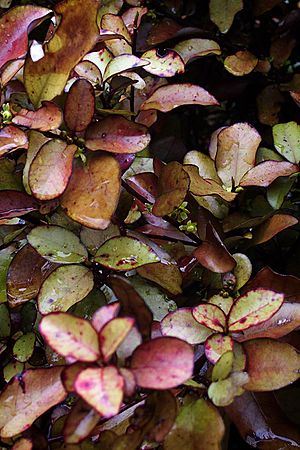Pseudowintera colorata facts for kids
Quick facts for kids Pseudowintera colorata |
|
|---|---|
 |
|
| Scientific classification | |
| Genus: |
Pseudowintera
|
| Species: |
colorata
|
Pseudowintera colorata, also known as mountain horopito or pepper tree, is a species of woody evergreen flowering trees and shrubs. It belongs to the Winteraceae family. This plant is only found in New Zealand. All plants in the Winteraceae family are magnoliids, which are ancient flowering plants often found in the humid Antarctic flora regions of the southern hemisphere.
Contents
What is Mountain Horopito?
Pseudowintera colorata, or mountain horopito, is an evergreen shrub or small tree. It usually grows about 1 to 2.5 meters (3 to 8 feet) tall. People often call it pepperwood because its leaves have a strong, hot taste, like pepper! It is also known as the New Zealand pepper tree or red horopito.
Early scientists noticed that horopito was similar to a South American plant called Drimys winteri. That plant provided a traditional medicine called "winter's bark." Both plants are part of the Winteraceae family. This family is mostly found in places that were once part of a huge southern continent called Gondwana. These places include South America, Australia, New Zealand, and New Guinea.
The leaves of the mountain horopito are yellowish-green with red blotches. In spring, the new leaves are a bright red color. You can find this plant in lowland forests and higher montane forests. It grows from about 36° 30' South all the way down to Stewart Island/Rakiura in New Zealand.
Where it Grows and What it Looks Like
Mountain horopito often grows in podocarp forests in places like Westland. In these forests, you might find it growing with other plants. Some of these include Rumohra adiantiformis, Ascarina lucida, Pseudopanax colensoi, Pseudopanax edgerleyi, and Blechnum discolor.
The flowers of the Winteraceae family are quite old in their design. This shows they come from some of the very first flowering plants. In New Zealand, horopito has been found in fossils for over 65 million years. It is special because its flowers grow directly from older stems, not from among the leaves. It is also a very slow-growing plant. Unlike most other flowering plants, it does not have special tubes to carry water.
How it Protects Itself
The evergreen horopito plant is always exposed to attacks from insects and other tiny living things. Since it grows in places with lots of rain, it is also very likely to be attacked by fungi. Because of this, the plant has developed strong ways to protect itself. Horopito has many natural chemicals that help it fight off these attacks. These chemicals have interesting properties that are useful for other things too.
Uses of Horopito
Pseudowintera colorata is used in several ways. People grow it as a spice because of its hot taste. It is also grown as an ornamental plant, meaning it is used for decoration. Most importantly, it has been used as a traditional medicine for a very long time.
Traditional Medicine Uses
The Māori, who are the native people of New Zealand, have used horopito for many purposes. They used it both inside and outside the body. As early as 1848, records show horopito was used to treat skin problems like ringworm. People would crush the leaves and soft branches and soak them in water. This liquid was then used for ringworm. The crushed leaves were also used as a poultice to help heal skin irritation, wounds, bruises, or cuts.
Infections caused by Candida albicans (which the Māori called Haha or Haka) were a big problem for Māori babies. This was often due to them not getting enough of the right foods. To help, the juice from horopito leaves was put directly into the baby's mouth. Sometimes, horopito leaves were soaked in water to make a strong liquid. This was used to treat what we now call candidiasis, or oral thrush.
Early European settlers in New Zealand also used horopito for medicine. For internal use, they would chew the leaves or make them into a tea. The leaves and bark have a strong, spicy smell and taste. Settlers sometimes used the leaves to help with diarrhea. A liquid made from the leaves was also taken for stomach aches. It was known as "Maori Painkiller" and "Bushman's Painkiller."
In the 1800s, some people used the bark of horopito as a replacement for quinine. Quinine was used to treat fevers. A French nun named Mother Aubert lived among the Māori people in the late 1800s. She learned about native plant remedies. She later created medicines that were sold and widely used in New Zealand. Horopito was one of two ingredients in her special medicine called Karana. In a letter from 1890, she said it was "better than Quinquina [quinine] for treating long-lasting stomach sickness." She also found it helpful for weakness, ongoing diarrhea, and recovering from fevers.
How Horopito Works
The main active chemical found in horopito leaves is called polygodial. This is what gives the chewed horopito leaf its very sharp, hot, peppery taste. Polygodial causes that strong feeling on the tongue even in very tiny amounts.
Studies have looked at how horopito works. One study used a mix of horopito and aniseed (a product called Kolorex). This mixture helped stop the growth of C. albicans in the mouth. The research showed that Kolorex worked well against many types of Candida fungi.
Another study found that a mix of horopito (with polygodial) and aniseed (with anethole) helped protect the gut of mice. It stopped Candida albicans from growing and spreading. Mice treated with Kolorex had much less C. albicans in their gut. This suggests that the horopito and aniseed product might help prevent Candida from taking hold early on.
See also
 In Spanish: Pseudowintera colorata para niños
In Spanish: Pseudowintera colorata para niños

